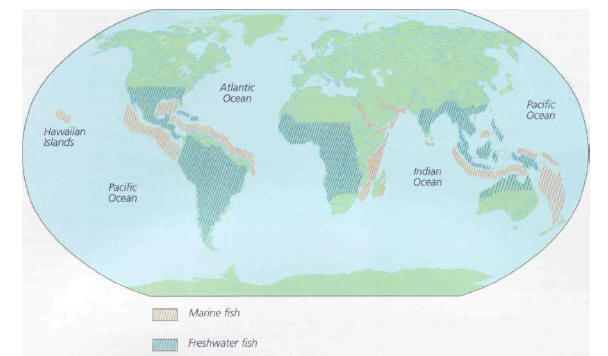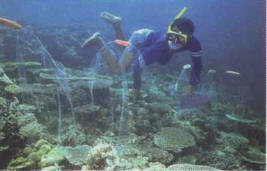WHERE DO AQUARIUM FISH COME FROM?
Feral and captive-bred fish
Today's hobbyist is unlikely to come across more than 300-500 of the 1,500 socalled
aquarium species. Formerly, these went under the name of tropical fish, as they
were caught in their natural habitats in tropical areas all over the world (see
map on following page). Nowadays, 80-85% of freshwater species are bred in captivity,
and by no means always in their native regions, so the term "tropical" is no longer
appropriate.
The dominant output is from South-East Asia, shared between Hong Kong, the Philippines
and Singapore, accounting for over three-quarters of species. The neon tetra. for
instance, originally from South America, is bred at the rate of thousands per month.

Outline distribution of tropical fish
Other areas of the world produce a limited range of species; some, like the former
Czechoslovakia, are beginning to breed on a large scale. Breeders either use imported
juveniles or raise their own stock, thus reducing the number of catches made from
the wild and helping to preserve the natural fauna. All the same, some species no
longer exist in their former abundance - for example in the Amazon basin - and proposals
are afoot to declare certain areas protected zones to safeguard local populations.

Catching tropical fish with a net.
As for marine fish, almost all species are caught in the wild. Aquarists are
frequently accused of abetting the plundering of coral reefs; the argument is that,
for every fish arriving in our aquariums, nine die at the time of capture, during
transport, or at various stages of handling. Without precise studies, it is extremely
difficult to know the real effects on the natural environment of catches that are
made to supply aquariums.
Harvesting of tropical marine fish
There was a time when any method of catching fish was considered legitimate:
explosives or cyanide were used to stun them, for example, inflicting severe losses
on their populations. At the present moment, the genuinely professional firms employ
more sophisticated and humane methods: a team of several divers works around a section
of reef after sealing it off with a net. After selecting fish according to various
criteria (especially size) and catching them in hand nets, they carefully bring
them to the surface and house them in holding tanks to await export.
Protected species
Hobbyists do not keep protected species; it is therefore unfair to blame them
for the reduction in numbers or disappearance of these fish from the wild. Most
aquarium species exist in large numbers in Nature; some even provide a food source
for the local human population.
|